Size and Images of Booths at Miami Art Basel
There are iii types of fairgoers.
First, y'all have the go-with-the-catamenia-er—the person who enters an art fair with no specific itinerary and wanders the aisles to meet what moves them. (Y'all might observe that the Venn Diagram between go-with-the-flow fairgoers and people with more 1,000 unread emails in their inbox is a circle.)
And so, there'due south the sharpshooter: someone who steps onto the floor with a marked-up map of booths to hit in a highly optimized order. (This person has probably reached inbox aught.) Finally, you have the optimist. This private begins with a plan to proceed aisle by aisle, berth by booth, just to fire out well-nigh a tertiary of the fashion through. They usually devolve into a become-with-the-flow-er on the manner out the door.
Tasked with finding the best booths at this year'southward Art Basel Miami Embankment, a fair with no fewer than 253 participating galleries, I realized none of these approaches was going to work. So I opted to dissever and conquer. Over the course of vi and a one-half hours, I hitting upward the fair's 4 main sections—Galleries, Nova, Positions, and Survey—and chose ane tin can't-miss booth from each (plus one extra from the galleries section, which is by far the largest).
Here are my picks. If yous programme to tackle the off-white this weekend, I hope they bring a flake of sharpshooter energy to your visit.
Daniel Faria Gallery
Toronto
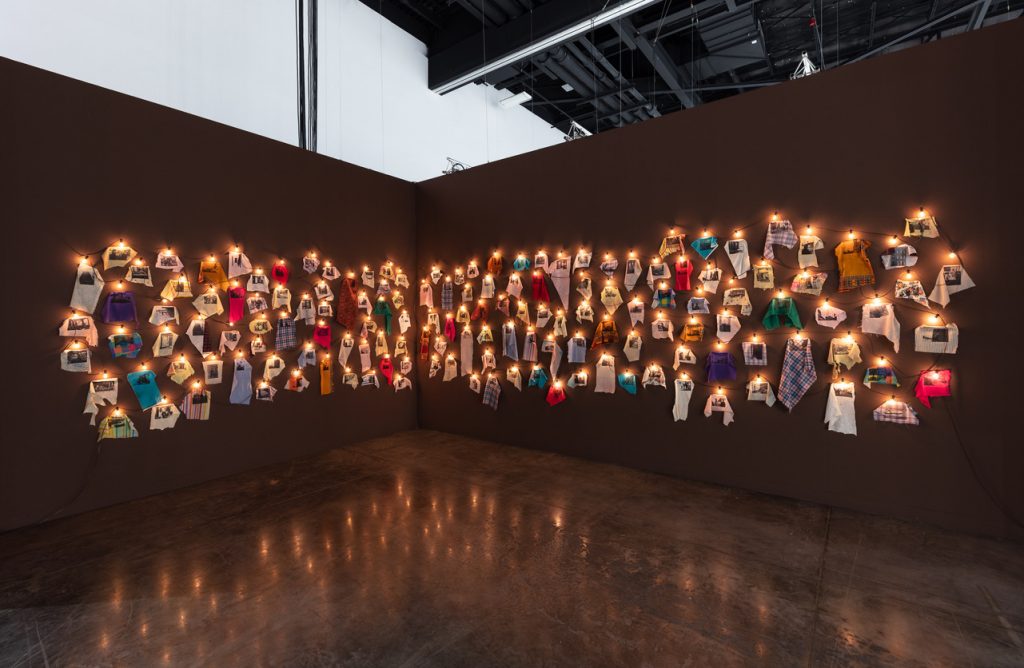
June Clark'due south Harlem Quilt (1997) at Daniel Faria's booth at Fine art Basel Miami Embankment 2021. Photo: Silvia Ros.
In 1997, during a residency at the Studio Museum in Harlem, the artist June Clark took her camera out onto the streets and photographed residents every bit they napped on the subway, waited at a crosswalk, and crowded effectually store windows. Using the same kind of transfer procedure one might use to personalize a t-shirt, she printed the images on scraps of fabric she nerveless from Goodwill. "She imagined that someone in the images may have owned the clothes she printed them on," said the gallery's director, Madeleine Taurins.
The effect is an installation that doubles every bit a deconstructed quilt and an intimate portrait of a neighborhood. At that place is a kind of alchemy in the simple materials—cloth, lightbulbs—that turns down the volume exterior the berth and encourages you to actually look.
Before its debut in Survey (Art Basel'south section for historical solo projects), Harlem Quilt had only been shown once before, during Clark's residency exhibition 24 years ago at the Studio Museum. While the artist is gaining recognition in her adopted domicile land of Canada, where she has lived since the 1960s (her work is in the collections of the National Gallery of Canada and the Art Gallery of Ontario), she remains lesser-known in the U.S. Hopefully, her memorable showing at the fair volition modify that. The installation is on offer for betwixt $250,000 and $300,000.
Wilding Cran Gallery
Los Angeles
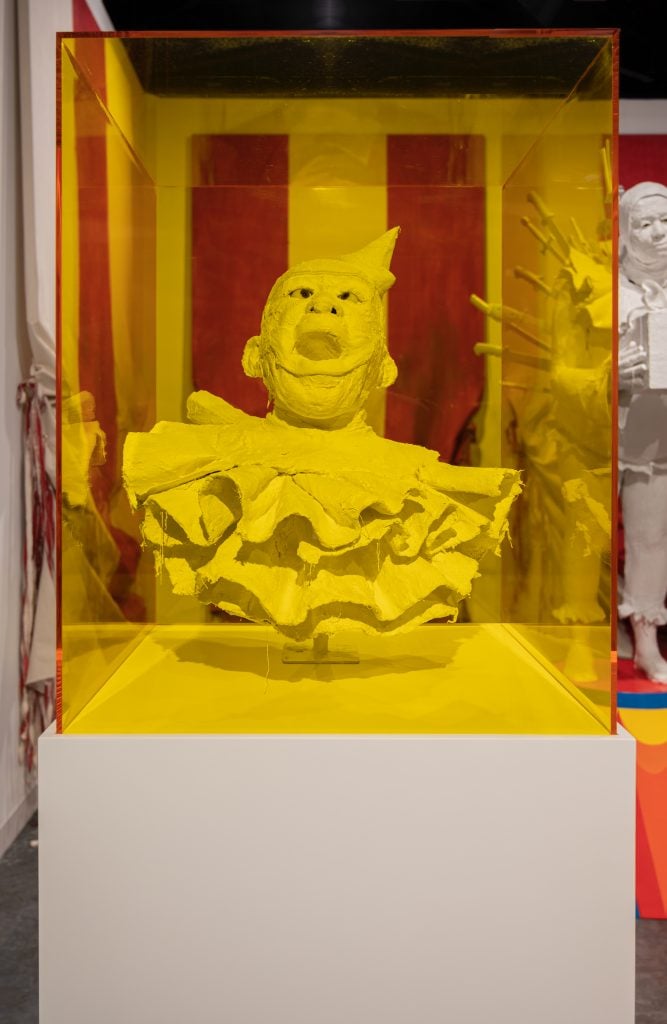
Karon Davis, Tragedy at Wilding Cran's berth at Art Basel Miami Beach. Photo courtesy of the artist and the gallery.
Art-world denizens frequently joke that fine art fairs are like a traveling circus—the aforementioned people in the aforementioned tent plopping downwards in urban center after city. That's why Karon Davis'due south installation in the Positions section (which is dedicated to solo presentations past young galleries) feels particularly apt. The Los Angeles-based artist, who too has a number of works on view this week at the Rubell Museum, created three sculptures of circus performers against a suite of paintings designed to recall a big-top tent.
The display might experience gimmicky if in that location weren't so much pathos in information technology. The central figure, based on a cast of Davis'due south own body, stands on a plinth with a gift in her easily and more a dozen knives in her back. One of the busts—based on her male parent, the famous Broadway performer Ben Vereen—is captured with his rima oris agape, as if he has been frozen mid-scream. (He is Tragedy; the other sculpture isOne-act.) The paintings, which represent Davis's first foray into the medium, have been dirtied with sand and patched to brand them look weary, every bit if they take lived a life on the road.
The gallery is offering the sculptures and paintings in groups to proceed the feel of the installation intact. Every bit of Tuesday afternoon, the key sculpture had sold with two canvases for $150,000, while the other two works, which come with ane canvas each, were on hold for $85,000 apiece.
Peter Blum
New York
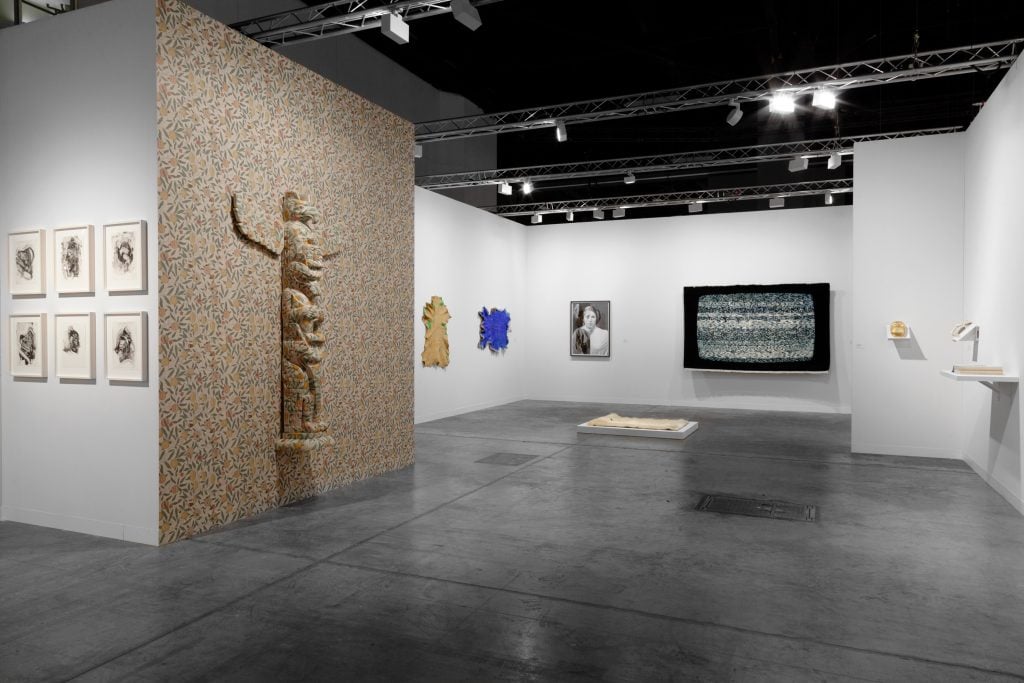
Installation view, Peter Blum's solo booth of Nicholas Galanin at Art Basel Miami Beach. Photo courtesy of the gallery.
For a gallery in the main department of the fair, it's customary—and often lucrative—to present an array of oversupply-pleasing works past a range of artists in the plan. Peter Blum's booth went against the grain.
At first, it might seem like a grouping brandish, with media ranging from wallpaper to photography to tapestry. Just upon closer inspection, it becomes articulate that the works are all by the aforementioned artist: the Alaska-based Nicholas Galanin. Created over the course of 12 years, each i explores—sometimes wittily, often greatly—how white America has appropriated Native land and civilisation, oft distorting history and disfiguring itself in the procedure.
I particularly resonant work past the Tlingit and Unangax̂ artist is The Imaginary Indian (Totem Pole) (2016), a carved totem installed in front of Victorian-era wallpaper and paw-painted to alloy right in. For Galanin, the work represents the European fetishization, appropriation, and flattening of Native cultural production.
Works on the stand up range in price from $10,000 for minor-scale editions to $135,000. Effectually one-half of the works on offer were sold past the end of the showtime VIP solar day.
Esther Schipper
Berlin
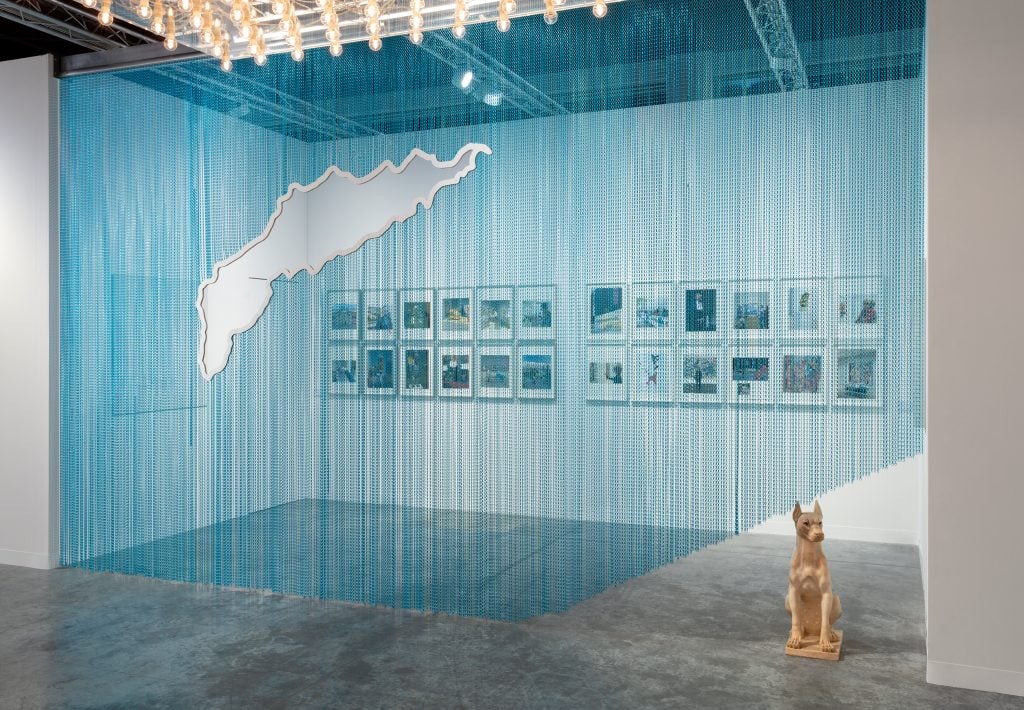
Installation view of Esther Schipper'due south booth at Art Basel Miami Beach 2021. Courtesy of the artists and Esther Schipper, Berlin. Photo © Sebastiano Pellion di Persano
When I think of people with a good sense of sense of humor, the Germans aren't necessarily at the top of my listing. Simply the Berlin gallery Esther Schipper may have the most cheeky, lighthearted, and fun booth in the chief section. The gallery installed a range of works that evoke a candy-colored funhouse—a window sculpture by Ryan Gander, an illuminated suspended marquee past Philippe Parreno, a bench (that y'all are actually allowed to sit down on!) past Liam Gillick. At that place'south even an aluminum curtain past the Spanish artist Daniel Steegmann Mangrané that conveniently serves to create a small oasis for the gallery'southward dealers, who are stationed behind information technology.
Mayhap the most delightful inhabitant of the stand is a series of new works past Simon Fujiwara that chronicle the adventures of a graphic symbol called Who the Baer (yes, that spelling is intentional). This baer is a cartoon grapheme who travels Google and pops into diverse art-world images to try on dissimilar personas. (In ane series, the baer makes their mode through the Met to requite some commentary about restitution.) Part of the series premiered at the Prada Foundation earlier this year; it will be the subject of a solo show at Esther Schipper in January. 2 of the three "Baer" works on offer sold at prices ranging from $20,000 to $35,000 each by the end of the first VIP preview solar day.
First Floor Harare
Harare
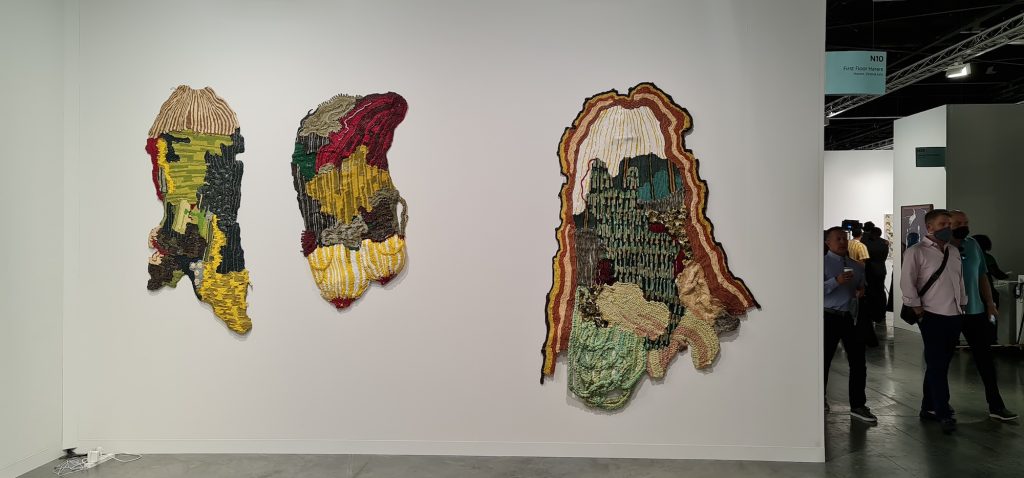
Works by Troy Makeza at Art Basel Miami Beach. Courtesy of the artist and First Floor Gallery Harare.
I know, I know —we're non supposed to touch the art. But if I were given special dispensation to bear upon any work on view at all of Fine art Basel Miami Beach, I would cull these luscious, tactile works past Zimbabwean artist Troy Makaza, on view at First Floor Harare'due south stand in the Nova section, which is dedicated to fine art made within the past three years.
Created with pigment-dyed silicone, they are somewhere in between painting and sculpture, with varied textures that evoke textiles and topographical maps. "Maps are about power and conclusion of access," gallery managing director Marcus Gora noted. For a young artist in Zimbabwe, "commenting on a political state of affairs in abstraction is easier considering it doesn't immediately offend."
The procedure is labor intensive: Makaza creates them by pipage the silicone out of a bag similar frosting or rolling information technology similar hand-pulled noodles. At only 27 years old, the creative person is already start to develop an international contour. His work has been shown at Zietz MOCAA in Cape Town and the Depart Foundation in Los Angeles; information technology's now in the collection of Miami patron Jorge Pérez. At the fair, 3 of his works had sold by mid-afternoon on VIP 24-hour interval at prices ranging from $viii,000 to $18,000.
Follow Artnet News on Facebook:
Want to stay ahead of the art world? Subscribe to our newsletter to get the breaking news, center-opening interviews, and incisive disquisitional takes that drive the conversation forrard.
Source: https://news.artnet.com/market/best-booths-abmb-2021-2042993
Post a Comment for "Size and Images of Booths at Miami Art Basel"